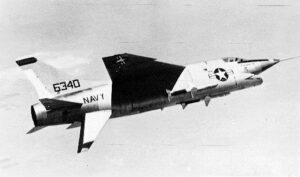2 June 1958 – The Vought XF8U-3 Crusader III, the “Super Crusader”. The Super Crusader “was an aircraft developed by Chance Vought as a successor to the successful Vought F-8 Crusader program and as a competitor to the McDonnell Douglas F-4 Phantom II.
 The XF8U-3 first flew on 2 June 1958. Despite claims by many books and articles that the aircraft reached Mach 2.6 at 35,000 ft (10,670 m) during testing, the maximum speed achieved was Mach 2.39, and normal operating speed was no more than Mach 2.32.[ The first time that the aircraft exceeded Mach 2.0 in level flight was on August 14, during its 38th test flight, well before the rival F4H-1 did so. Some sources state that Vought projected a top speed of Mach 2.9 with the tail rocket installed, though the windscreen and most aluminum airframes were not designed to withstand the effects of kinetic heating at speeds of more than Mach 2.35.
The XF8U-3 first flew on 2 June 1958. Despite claims by many books and articles that the aircraft reached Mach 2.6 at 35,000 ft (10,670 m) during testing, the maximum speed achieved was Mach 2.39, and normal operating speed was no more than Mach 2.32.[ The first time that the aircraft exceeded Mach 2.0 in level flight was on August 14, during its 38th test flight, well before the rival F4H-1 did so. Some sources state that Vought projected a top speed of Mach 2.9 with the tail rocket installed, though the windscreen and most aluminum airframes were not designed to withstand the effects of kinetic heating at speeds of more than Mach 2.35.
Fly-offs against the Crusader III’s main competitor, the future McDonnell Douglas F-4 Phantom II, demonstrated that the Vought design had a definite advantage in maneuverability. John Konrad, Vought’s chief test pilot, later stated that the Crusader III could fly circles around the Phantom II. Combat thrust-to-weight ratio (T/W ratio) was almost unity (0.97), while early F4H was only at 0.87. However, the pilot in the XF8U-3 was easily overwhelmed with the workload required to fly the intercept and fire Sparrows which required constant radar illumination from the firing aircraft, while the Phantom II had a radar intercept officer to share the workload.
In addition, with the perception that the ‘age of the gun’ was over, the Phantom’s considerably larger payload and the ability to perform air-to-ground, as well as air-to-air missions, won over Vought’s fast but single-purpose fighter. For similar reasons, the Phantom would replace the Navy’s F-8 Crusader as the primary daylight air superiority fighter in the Vietnam War, although it was originally introduced as a missile-armed interceptor to complement day fighters like the Crusader.
The F8U-3 program was canceled with five aircraft built. Three aircraft flew during the test program, and, along with two other airframes, were transferred to NASA for atmospheric testing, as the Crusader III was capable of flying above 95% of the Earth’s atmosphere. NASA pilots flying at NAS Patuxent River routinely intercepted and defeated U.S. Navy Phantom IIs in mock dogfights, until complaints from the Navy put an end to the harassment.
All of the Crusader IIIs were later scrapped.”
Source: Wikipedia
